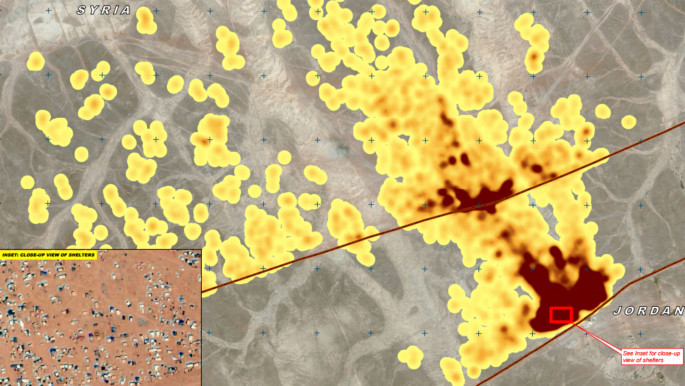Famine and disease 'rife' at Syria-Jordan border
The human rights NGO released new images clearly showing a graveyard near Rukban, providing a new insight into the terrible conditions of the makeshift refugee camp.
"It's a desperate picture for people trapped at the berm, food is running out and disease is rife," said Tirana Hassan, crisis response director at Amnesty International.
"In some cases people are suffering or even dying from preventable illnesses, simply because they are not allowed into Jordan."
According to Amnesty, the number of shelters at Rukban has increased from 368 in 2015 to more 8,295 in September 2016.
Food and clean water supplies are also low, which Amnesty believe has caused an outbreak of hepatitis, a leading cause of death among children.
 |
|
| Images of the makeshift graveyard at Rukban camp [source: Amnesty International] |
Last week, Human Rights Watch released satellite footage showing long queues waiting for a limited number of water pipes.
Nadim Houry, deputy Middle East director at Human Rights Watch said: "Jordan should immediately allow humanitarian agencies to resume life-saving aid deliveries to alleviate their suffering."
The Jordanian army has prevented any aid from accessing the camp since 21 June 2016, after Islamic State group-linked militants bombed a military site close to the border.
After the attack, King Abdullah said that Jordan would respond with an "iron fist" to threats against its security and borders.
"No humanitarian aid agency has been able to access the Rukban camp since last month," said a source who was aware of the situation in the camp.
"There are many agencies in a close circle negotiating with the government to provide a feasible solution to the security situation, but it is very complex.
"We know that there are elements of ISIS in the area but they do not control the camp - it is a very concerning situation."
 |
|
| The proliferation of tents at the Rukban camp in September 2016 [copyright Airbus, source: UNOSAT-UNITAR] |
According to Amnesty International, conditions at the Rukban camp have deteriorated since the 21 June attack.
"The humanitarian situation is very bad, the situation of children in particular is very bad. We have drinking water but hardly any food or milk," said Abu Mohammed, a refugee at the camp.
"Many people have died… They distributed just rice and lentils and a kilo of dried dates, but that was all for a whole month, they gave us nothing but that. The mood among the people in Rukban is below zero."
It is not currently possible to reliably count the number of deaths at the camp, due to the lack of access for aid workers.
Medical aid charity, Doctors Without Borders, has previously described the situation at the camp as a "massive failure of the international community".
According to official UN statistics as of July 2016, Jordan currently hosts 657,422 Syrian refugees, however the total is closer to 1.4 million.





 Follow the Middle East's top stories in English at The New Arab on Google News
Follow the Middle East's top stories in English at The New Arab on Google News
![Israeli forces ordered bombed Gaza's Jabalia, ordering residents to leave [Getty]](/sites/default/files/styles/image_330x185/public/2176418030.jpeg?h=a5f2f23a&itok=_YGZaP1z)

